Greening the Desert
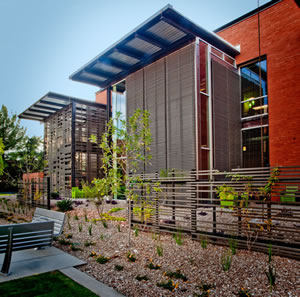
PHOTOS COURTESY OF ARIZONA STATE UNIVERSITY
A combination of practical operational tactics and public pledges is what moves Arizona State University (ASU) toward becoming a climate-neutral institution. The largest public university in the country is working to achieve zero greenhouse gas emissions (not including transportation) by 2025 and including transportation by 2035.
ASU has teamed up with industry and joined leaders across higher education to underscore its climate-neutral commitments:
- ASU President Michael Crow is a founding signatory of the American College and University Presidents’ Climate Commitment.
- The university partnered with Ameresco, Inc., and the nonprofit Rocky Mountain Institute in 2013 to finalize a seven-year contract that includes development of a climate action plan.
“Since 2005, we have reduced our greenhouse gas emissions by 15.3 percent, and our landfill waste by 24.3 percent despite adding 29 percent more space and 33 percent more students,” says John R. Riley, ASU associate vice president for business services and the university sustainability officer.
The university’s day-to-day sustainability efforts include recycling and back-of-the-house composting at select campus eateries and athletic events. The Sun Devil definitely is in the sustainability details throughout university operations, including:
- Solar photovoltaic and solar thermal installations
- Biodiesel use in facilities vehicles
- Energy performance contracts
- A green revolving fund
- Green Labs practices
- Green purchasing policies
- Green Office certification
- A sustainable design policy
A Sunny Approach
Located in the desert Southwest, Arizona has more than 300 sun-drenched days each year. Therefore, implementing solar photovoltaic and solar thermal installations was a natural fit for ASU.
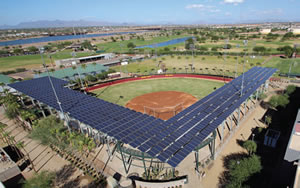
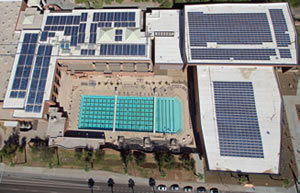
PHOTOS COURTESY OF ARIZONA STATE UNIVERSITY
HERE COMES THE SUN. As of July 23, 2014, Arizona State University has a total of 86 solar energy installations across all of its campuses —Tempe, Downtown Phoenix, Polytechnic, West and the ASU Research Park. Total wattage is more than 23.5 megawatts.
By the end of summer 2014, ASU is expected to have 89 solar installations operating across its four campuses and at the ASU Research Park. ASU will reach nearly 25 megawatts of solar energy generation capacity, which is approximately 45 percent of the university’s current daytime peak load.
The university has worked with business partners in the financial and energy sectors to build its solar portfolio.
ASU solar installations on the Tempe, West and Downtown Phoenix campuses are facilitated, in part, by Arizona Public Service’s (APS) Renewable Energy Incentive Program. Solar installations on the Polytechnic campus and ASU Research Park are facilitated, in part, by Salt River Project’s (SRP) EarthWise Commercial Energy Incentive program.
ASU owns 10 solar systems and buys all of the power generated from the remaining systems, which are third-party owned and operated. Third-party investments for installations in use, construction and design total more than $176 million. ASU can option to own and run a solar system after its third-party agreement expires.
“New construction either includes solar, or can be equipped with solar in the future,” says Bruce Jensen, interim associate vice president of ASU Facilities Development and Management. “The panels’ shading provides a cooling effect that can extend a building’s roof life, and help keep maintenance costs low.”
Beyond its Arizona campuses, ASU ranks number one on the top ten campuses by total installed capacity list compiled by the Association for the Advancement of Sustainability in Higher Education (AASHE). Additional ASU solar details can be found at asusolar.asu.edu.
Greening the Fleet
To service facilities fleet vehicles with a greener option, ASU introduced a 1,000-gallon B99 biodiesel fuel tank and dispensing system on its Tempe campus. B99 is made from 99-percent used vegetable oil that is collected from ASU Tempe campus Aramark foodservice locations.
The B99 project involved ASU departments as well as Aramark, REVbiodiesel, and Brown Evans Distributing — an ASUalumni-owned company. About twice a month when the tanks are full, the oil is collected. It takes about seven days for the oil to be collected, converted to B99 and then it is ready for use. During the 2013-14 academic year, 4,150 gallons of oil were collected.
B99 replaced petroleum diesel used in about half of the ASU Grounds’ maintenance vehicles and equipment and in one Surplus Property department vehicle.
“We will probably never be 100 percent B99 use because it is not suitable for pieces of equipment that are not used all of the time — tractors, for example,” says Ellen Newell, associate director, ASU Facilities Development and Management. “As we purchase new equipment, if diesel is a viable choice, we will use B99.”
So far the vehicles and equipment have not incurred any maintenance issues since switching to B99 from petroleum diesel. “We have been able to go from diesel to biodiesel to diesel and back to the B99 with no problems,” Newell added.
As of January 2014, using B99 in university equipment and vehicles reduced CO emissions by more than 42 metric tons.
Energy Performance Contracts
Since 2002, ASU has completed two comprehensive energy audits conducted by Ameresco Southwest, a local ESCO (Energy Services Company). An initial 2002 energy audit covered 86 buildings and 6.3 million square feet. The audit identified $34 million in energy conservation measures (ECMs) for the ASU Tempe campus. Reviewed items included a detailed lighting and energy study, as well as a review of the Tempe campus central plant and cogeneration possibilities.
ASU selected Ameresco as its general contractor for a multi-year energy savings performance contract following the audit, which encompassed nearly a dozen ECMs, including:
- Air handling unit replacement
- Energy management system upgrade, expansion and commissioning
- Retro-commissioning of buildings
- Water conservation measures: toilets, urinals and faucets
- Variable frequency drives for exhaust fans
- Window replacement
- Lighting controls and retrofits
- Tempe campus Energy Metering Project
The university’s annual savings from these first-phase projects totaled $3.324 million.
In 2007, Ameresco conducted a new energy audit encompassing 4.7 million square feet that identified an additional $100 million in energy efficiency and renewable energy projects. From this audit, ASU selected $40 million in energy-efficient upgrades on the Tempe and West campuses that were not completed during the first phase. The estimated annual energy savings for phase two, which began in late 2008, were just over $4.725 million.
One phase-two initiative was the expansion of ASU’s Energy Metering Project — also known as the Energy Information System — to the other three ASU campuses. ASU uses this system to measure and monitor utility use, see quickly where use concerns exist, and respond swiftly to correct any concerns. The project’s projected annual cost savings is $240,000. The $1-million Energy Metering Project was funded by SIRF (Sustainability Initiatives Revolving Fund), ASU’s green-revolving fund.
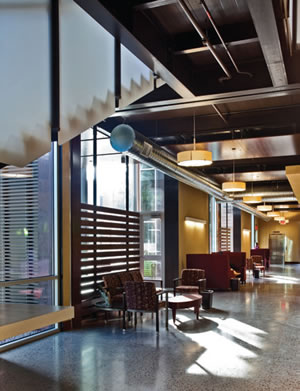
PHOTOS COURTESY OF ARIZONA STATE UNIVERSITY
Green Fund Grows Campus Sustainability
SIRF supports sustainable ideas brought forward by university students, faculty and staff that support campus infrastructure and provide an economic return on investment. As of June 30, 2013, 25 SIRF-approved projects totaled $5.6 million. SIRF is comprised of three tiers:
- $5,000 micro grants with no tangible return on investment required.
- Fund matching and efficiency loans that require SIRF project cost return on investment and payback within six years or less.
- Capital expansion loans require a financial return to achieve a net present value of $10,000 or a return on investment of eight percent or more.
Most projects that currently are funded will have a return on investment far greater than eight percent, and will increase the value of the fund as a result.
During FY 2013, six student and campus-oriented projects and seven energy-related conservation projects were funded. The upfront investment in the seven energy-related projects totaled $1.9 million, and the projected annual benefits totaled $382,518.
ASU Downtown Phoenix campus FY 2013 SIRF-funded projects include:
- A $73,945 window film project that is expected to achieve $16,190 in annual energy savings. Employees now experience less heat and glare through the building’s single-pane glass. In addition to the annual energy savings, the project received $22,077 in one-time utility rebates.
- A $5,000 urban instructional garden (seen on page 26). ASU nutrition courses and programs can use sustainable food and herbs in instructional kitchens.
The ASU Office of Planning and Budget manages SIRF with oversight from a multidisciplinary, eight-person review committee.
“Nearly $1 million is incorporated in the FY 2014 annual budget for reinvestment in future SIRF-funded projects,” says Lisa Frace, associate vice president of ASU Planning and Budget, and SIRF committee chairperson.
Labs Go Green
While window film installations are an energy-efficiency option for a building’s exterior, ASU’s Environmental Health and Safety (EH&S) department estimates that laboratories use three to eight times the energy of comparable-sized office buildings. Labs sometimes operate on a 24/7 cycle and create higher electrical energy use from autoclaves and fume hoods.
ASU currently has more than 1,400 labs totaling 1.6 million gross square feet. All labs are required to renew EH&S lab safety registrations annually, so the opportunity presented itself to introduce a Green Labs program. The Green Labs’ goals primarily are to reduce all types of waste and to conserve energy.
A Green Labs coordinator is selected and manages a lab’s initial goals. The coordinator also can request EH&S support to help identify future lab goals and safe-work practices. Green Labs’ feedback also is important to EH&S. For example, a small group of engineering students conducted a random-sample survey of the existing 240 Green Labs. Some of their feedback and certified Green Labs activities created:
- Closing 62 fume hood sashes, resulting in more than 750 hours of air exhaust per day.
- Turning off lights in 90 unoccupied areas, saving more than 1,000 hours of electricity use per day.
- 233 locations participated in recycling electronics (e.g., batteries) and commingled materials.
Getting the Green Labs word out beyond ASU also is a priority. ASU partnered with Harvard University’s sustainability coordinator in 2012 to develop a Green Labs workshop.
“We hosted and presented a Green Labs workshop to 22 other university representatives interested in learning how to build a Green Labs program at the University of Maryland’s ‘Smart and Sustainable Campus Conference’,” says Michael Ochs, Green Labs founder and ASU assistant director of occupational health and safety.
The university also is a founding member of the Google Green Labs Planning Group. According to Ochs, this group created an electronic warehouse for sharing sustainable lab best practices. “There currently are 166 group members with 216 shared topics,” he says.
Green Purchasing
Deeper into the organization, ASU established green purchasing practices to help curb energy use, conserve water and to reduce waste that includes:
- Use no- or low-volatile organic compound (VOC) products.
- Purchase 100-percent recyclable carpeting.
- Contract with an office supply company that stocks recycled products.
- When possible, locate snack machines inside buildings so that they do not require refrigeration.
- Shut off all panel lights in exterior vending machines.
- Vending contracts require the use of EnergyMiser energy conservation devices.
- Obtain ENERGY STAR products.
ASU also has a green purchasing policy that extends to the companies that wish to do business with the university. Vendors and bidders must follow stipulations such as using recycled paper and double-sided copying for all documents they create when conducting business with ASU. Solicitations require that packaging and packing materials have to meet at least one (and preferably all) of these criteria: Made from recycled materials, recyclable or reusable, or nontoxic or biodegradable. Vendors and bidders are required to pick up packaging and either reuse it or recycle it. They also must answer an extensive green profile questionnaire that includes questions about energy, solid waste, water waste, packaging, company practices and community involvement.
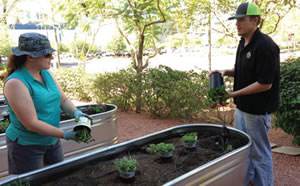
PHOTOS COURTESY OF ARIZONA STATE UNIVERSITY
ASU extended its green purchasing principles to industry partners when it became a founding member of the Sustainable Purchasing Leadership Council (SPLC, www.purchasingcouncil.org). Launched in July 2013, the nonprofit organization’s mission is to “support and recognize purchasing leadership that accelerates the transition to a prosperous and sustainable future.” ASU is one of 88 current SPLC companies range from Dell to The U.S. Departments of Agriculture and Energy, FedEx and Lockheed Martin.
Green Around the Office
Employees can engage in sustainability practices that support ASU’s climate neutrality goals directly from their cubicles by participating in the ASU Green Office program.
The three-level program can be facilitated by a University Sustainability Practices staff member, or self-guided by a designated department employee. Online presentations and checklists are available for the self-guided option. Each level covers several basic sustainable office practices, including:
- Create a carpool calendar.
- Set printers to a standard double-sided option.
- Share office supplies such as staplers, hole punches, etc.
- Bike, light rail or bus to work.
- Buy consumable items in bulk for kitchens and break rooms.
- Participate in ASU’s blue bin commingled recycling program.
Over 90 offices across ASU currently are Green Office-certified.
Numerous sustainable practices are in effect and range from the installation of a kitchen water filtration system to participation in “Grounds for Grounds.” The Tempe campus-based program diverts used espresso and coffee grounds from the landfill by using them as a natural fertilizer.
The Green Office program supports the university’s climate neutrality goals and fosters fellowship among office staff members.
Green From the Ground Up
In all major new construction and renovation projects, ASU strives for a minimum U.S. Green Building Council’s (USGBC) LEED certification. ASU has 40 freestanding LEED-certified buildings; two are certified Platinum. The university achieved the state’s first LEED Platinum certification in 2007. In 2012, the USGBC Arizona Chapter granted ASU two awards for its LEED accomplishments:
- Highest LEED Achievement – Most Certifications in Arizona
- LEED New Construction – Most LEED Gold Certifications
The USGBC awards reflect the university’s attention to sustainable design. The ASU Office of the University Architect maintains that all design professionals, contractors and third-party developers are required to meet LEED Silver minimum certification on major new construction or renovation projects over $5 million. The university additionally established a Sustainable Design Policy and extensive guidelines that include:
- Meet space requirements and minimize the overall square footage and footprint.
- Reduce, reuse and/or recycle construction waste materials and divert them from area landfills.
- Maximize instances to produce landscape shading and cooling, exterior spaces and walkways and identify low-maintenance and desert-appropriate plant materials.
- Use permeable and reflective surfaces to reduce runoff and to decrease the urban heat island effect.
- Incorporate certified low-water use plumbing fixtures.
- Eliminate or decrease volatile organic compounds (VOC) use on interior finishes.
An advisory committee that consists of university faculty, students and professionals in sustainable design and construction disciplines oversees the sustainable design guidelines and is required to review all projects over $5 million for sustainable design guidelines compliance, work with the project team to increase sustainability opportunities and provide a summary report to the CFO.
“Our attention to sustainable design enables us to create beautiful, functional and sustainable spaces that can be enjoyed by Sun Devils for decades to come,” says Morgan R. Olsen, executive vice president, treasurer and chief financial officer at ASU. “In the bigger picture, our sustainability vision begins with our campus leaders, is supported by our industry partners and is achieved through an everyday, operational approach; all factors working to help ASU achieve climate neutrality.”
This article originally appeared in the issue of .